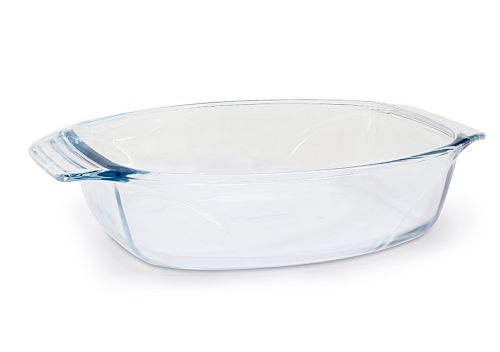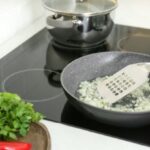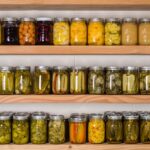Glass is a completely toxin-free and environmentally friendly material. It can be a good choice if you plan to stock your kitchen with healthy cookware.
Glass bakeware is considered safe for food contact because glass is a non-porous and chemically inert material. Glass neither leaches chemicals into your meals nor reacts with acidic foods. A non-porous glass surface is easy to clean and disinfect after use because it does not trap food particles and does not absorb food odors and flavors. Glass bakeware features versatility, one-dish convenience, and attractiveness. Glass dishes are safe to use in the microwave and they are perfect for heating and storing leftover food.
The main disadvantages of glass cookware are its fragility and intolerance to sudden temperature changes. A sudden temperature change (thermal shock) causes the glass to expand or contract, which can result in breakage.

What is Tempered or Toughened Glass?
Tempered glass is a type of safety glass that is particularly strong and heat-resistant. The hardening process makes the glass more than five times stronger than normal glass. When tempered glass does break, it shatters into small, relatively harmless pieces with no sharp edges, reducing the risk of injury.
Heat-Strengthened Glass
Heat-resistant glass is a type of glass with an increased ability to withstand thermal changes without breaking. This type of glass is suitable for kitchen applications where intense heat and sudden cooling can cause the regular glass to shatter.
Some glass cookware is suitable for use in the oven and on the stovetop, while others can only be used in the oven. Heat-resistant glassware is usually made from borosilicate glass, tempered soda-lime glass, or glass ceramic.
What is Borosilicate Glass?
Borosilicate glass is a type of heat-resistant glass that can withstand extreme temperatures better than other types of glass. This type of glass is used for manufacturing high-quality kitchenware. Borosilicate glass cookware is thin, durable, safe, and practical for cooking, baking, serving, and storing food.
While the two major brands of glass bakeware in the USA, Pyrex, and Anchor Hocking, used to be made from borosilicate glass, that is no longer the case.
How is Glass Bakeware Made?
To comply with the United States’ new and stricter air pollution regulations after 1980 and to reduce manufacturers’ costs of installing the new pollution control equipment, Anchor Hocking Company and World Kitchen, owner of the Pyrex brand, changed their manufacturing process. Both companies switched from using tempered borosilicate glass to a less expensive tempered soda lime glass.
While European Pyrex glass bakeware is still made from borosilicate, the majority of glass cookware produced in the United States today is made from tempered soda-lime silicate glass. Many consumers still associate borosilicate with Pyrex because they do not realize that the formulation of Pyrex glass bakeware has changed over the past few decades.
Certain manufacturers use borosilicate glass, which undergoes an annealing process, to produce baking pans with tremendous stability against thermal shocks. The Borolux company (USA) claims that its patented borosilicate formula bakeware will never break due to thermal shock and offers a lifetime guarantee on all its products.
International Cookware from France offers a wide range of borosilicate glass bakeware with excellent heat resistance.
Simax® Glassware made in the Czech Republic has been known for over 200 years. The Simax glassware product line is made from 3.3 borosilicate glass, which features high resistance to thermal shock and superior chemical resistance.
Related product: Simax Glass Casserole Dish With Lid (can withstand temperatures between 572° and -40° Fahrenheit (300°/-40° Celsius).
Borosilicate Versus Soda Lime Silica Glass
According to the manufacturers of soda lime glass, the glass has superior mechanical strength and is much less likely to shatter if dropped or bumped into something. However, it has a significantly lower resistance to extreme temperatures than borosilicate glass.
When soda lime glass breaks, it tends to shatter into small pieces without sharp edges, resulting in less serious injuries from the broken glass.
Borosilicate glass is more resistant to breakage caused by rapid temperature changes but is significantly weaker to mechanical forces such as falling or hitting a hard object.
If broken borosilicate glass tends to shatter into large, very sharp pieces of glass, the chance of serious cuts from the broken glass is higher.
Ceramic Glass Cookware
The glass ceramic material has high strength and exceptional resistance to thermal shock, withstanding constant temperatures up to 1256 degrees F. The best-known glass-ceramic material is Pyroceram, developed by Corning Glass in the 1950s. Pyroceram was first used in rocket nose cones because this material can withstand extreme temperature changes.
Pyroceram® is often used for kitchen applications where there is a risk of thermal shock. Corning Ware, a Pyroceram cookware line, was introduced in 1958 and gained popularity due to its exceptional durability and versatility.
CorningWare’s original Pyroceram glass version was withdrawn from production in the late 1990s but was reintroduced to the market in 2009 due to consumer demand. To ensure you are purchasing the original version, check the manufacturer’s guidelines on the packaging. Original CorningWare cookware should be highly resistant to thermal shock and safe for stovetop use.
The original Pyroceram version of CorningWare glass ceramic cookware can be used directly on the stove, in the oven, in the microwave, or under a broiler. These dishes can go straight from the freezer to the oven and from the oven to the freezer. They can go into the dishwasher and can be immersed in the soapy water before cooling without fear of cracking or breaking.
Related product: CorningWare Glass-Ceramic Pyroceram Round Classic Casserole (can withstand sudden temperature changes of up to 840 Fahrenheit)
Why Does Glass Bakeware Shatter?
The most common cause of glass cookware breaking is mechanical impact, such as hitting something or falling on a hard floor.
Thermal stress is another cause of fractures caused by sudden changes in temperature. Glass is not a good conductor of heat and sudden changes in temperature will cause parts of a glass vessel to expand or contract more than other parts, which can result in breakage. “Thermal shock” occurs when glass goes from hot to cold or cold to hot too quickly, such as when a hot dish is placed directly on a cold surface. In some cases, the failure occurs slowly and the breakage does not occur immediately after the vessel has been mishandled. But after sitting long enough the glass structure will fail suddenly. That is why sometimes seems that a glass dish breaks without any apparent reason.
Thermal breakage is sometimes caused by repeated heating and cooling cycles during normal kitchen use. Each cooking process causes minor damage to the inside of the jar until the damage causes the cookware to break.
The most common cause of soda lime cookware breaking is the formation of invisible cracks over time. Once a hot liquid enters these invisible cracks, the soda lime glass will shatter, causing a mess and possible injury.
How to Prevent Glass Bakeware from Shattering?
Over the last two decades, accidents involving Pyrex and Anchor Hocking glass bakeware have become increasingly common. In some cases, consumers have been injured by a sudden “explosion” of glassware. Over recent years there has been a long debate about whether manufacturers or users are responsible for accidents. Manufacturers say errors occur because a small number of consumers do not use their products according to the safety instructions on the packaging.
To reduce the risk of these incidents, which can result in serious injury, consumers should follow safety warnings and read the use and care instructions included with new glass bakeware. Here are some basic tips for safely using glassware for cooking and baking.
- Never place hot glassware directly on a cool or wet surface as the temperature contraction will be greater than the glass can withstand. Also, do not place hot dishes directly on the countertop, metal surface, or sink. To slow the cooling process, place it on a dry cloth, or towel to minimize contact with a cold surface.
- Do not place glass bakeware directly on a burner or under a broiler. Do not take glass baking pans directly from the freezer to the oven or vice versa.
- Get rid of glass baking pans that are chipped, cracked, or scratched, as such pieces are more likely to break.
- Do not pour hot liquids into empty, cold glass cookware, and never pour cold liquids into hot glass baking dishes. The sudden expansion or contraction can cause it to break.
- Always allow the oven to fully preheat before placing glassware inside.
- Cover the bottom of a glass baking dish with liquid before cooking meat or vegetables.
- Allow your bakeware to cool completely before washing, refrigerating, or freezing.
- Never use glass bakeware at temperatures above 350°F, except ceramic glass.





JSG Oceana bakeware produced by Jeannette Specialty Glass in the USA is made of borosilicate glass. Please, contact for complete details.
According to their website, they are out of business.
I just purchased 3 borosilicate glass food storage containers that come with pretty aqua lids. Am I able to “microwave” the containers with the lid on or not cover them at all I don’t want the lids to melt. Help!!
I would suggest against microwaving with the lids in place. There is no way of knowing what type of plastic they are made from and some plastics may release toxic chemicals at high temperatures, even if they do not melt. For example, Teflon when heated to higher than 464F releases carcinogens.